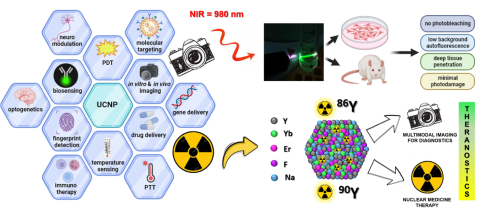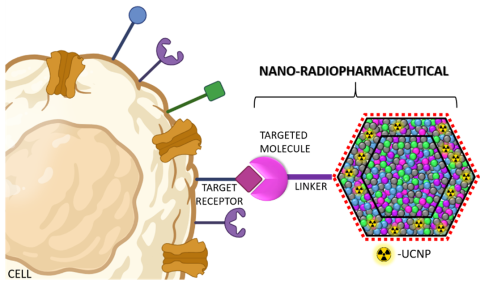Sonatina 8 NCN Karolina Zajdel
Dr Karolina Zajdel is a laureate of the SONATINA 8 grant from the National Science Centre, entitled “Radiolabelled up-converting nanoparticles as theranostic agents for multimodal imaging and targeted therapy.”
The scientific goal of this project is to develop and synthesize new nano-radiopharmaceutical tools for theranostic applications. These tools will be based on a new generation of core or core@shell up-converting nanoparticles radiolabelled with diagnostic and therapeutic radionuclides.
Among the currently available nanostructures, the emerging class of up-converting nanomaterials (UCNPs) appears to fulfil the aforementioned requirements and is gaining popularity. UCNPs are luminescent nanomaterials composed of fluorides, oxides, or sulphides matrices doped with rare earth element ions, including Ln3+ ions such as: Er3+, Yb3+, Tm3+, Tb3+, Gd3+, Ho3+, Eu3+, and Nd3+, as well as transition group metals like Fe3+, Mn2+, Cr3+, Re4+, V3+, Mo3+, Ni2+, Ti2+, Ca2+, Zr4+, and Y3+. UCNPs are an interesting class of inorganic luminescent nanomaterials due to their unique spectroscopic properties, enabling luminescence upon excitation - a characteristic feature of this group of compounds. By incorporating rare earth ions into their structure, UCNPs naturally emit light in the visible (VIS) or ultraviolet (UV) range when exposed to near-infrared radiation (NIR). Luminescence emission is found on the up-conversion process (UC), also recognized as anti-Stokes radiation. UCNPs also offer the advantages of relatively low cytotoxicity, excellent photo-stability, resistance to photo-bleaching, and absence of auto-fluorescence from organic compounds in biological materials. This makes UCNPs a powerful imaging tool for both in vitro and in vivo applications. Additionally, the choice of dopant ions in UCNPs can impart new properties or determine the emitted light colour e.g., Tm3+ for blue, Er3+ and Tb3+ for green, Sm3+ for orange, or Eu3+ for red. Certain paramagnetic lanthanides, such Gd3+, Eu3+, Dy3+, Ho3+, Er3+, Tm3+, and Tb3+, can induce relaxation in water protons, making them suitable as contrast agents in Magnetic Resonance Imaging (MRI). UCNPs' chemical composition enables their use in multimodal imaging, combining luminescence as a fluorescent tracer and magnetic resonance for contrast agent enhancement. This approach enhances diagnostic accuracy and provides a more complete picture of the studied subject. But the most intriguing aspect is the potential utilization of the chemical composition of UCNPs for multimodal imaging, leveraging their inherent capability for photoluminescence imaging (PL), while also incorporating dopant ions for nuclear medicine imaging, such as positron emission tomography (PET) and single-photon emission computed tomography (SPECT), to detect radioactivity.
Biomedical applications of up-converting nanoparticles (UCNPs)
Transforming nuclear medicine with modern nano-radiopharmaceuticals demonstrate high efficiency by enhancing diagnostic accuracy, improving therapeutic outcomes, and minimizing off-target effects and healthy tissue damage. A nano-radiopharmaceutical is a nanosystem comprising nanoparticle, radionuclide and targeted biomolecule serving as a specific biological ligand. From a practical perspective, the characteristics of nano-radiopharmaceuticals offer significant advantages in terms of diagnostic and therapeutic sensitivity and specificity, imaging resolution, and scalability of the final nanoplatforms. Ideally, the objective is to develop nanoparticles that possess both diagnostic and therapeutic capabilities concurrently, embodying the concept of theranostics, which integrates "therapy" and "diagnosis" within a single nanoplatform. Consequently, there is a need for nanomaterials that are multifunctional and efficient, while also being cost-effective to produce and demonstrating high biocompatibility and minimal cytotoxicity in biological systems. Nowadays, the escalating number of publications pertaining to radiolabelled nanomaterials for biomedical applications each year underscores the burgeoning interest in this field.
Nano-radiopharmaceutical scheme based on the example of UCNPs
The main goal of this study is to synthesize, characterize, and radiolabel UCNPs for theranostic applications. The chosen chemical composition of β-NaYF4:20%Yb3+,2%Er3+ UCNPs, known for their superior luminescent and physicochemical properties suitable for biological applications, utilize a matrix based on NaYF4. Yttrium (Y) is a key component of NaYF4 matrix, has two interesting radionuclides: the therapeutic 90Y and the diagnostic 86Y, both of which are significant for nuclear medicine. To our knowledge, the first attempt in Poland will be made to develop a novel tool for medical applications, based on the utilization of next-generation UCNPs radiolabelled with 90Y and 86Y radioisotopes. The screening of world literature data reveals only a few attempts at the same approach of 90Y labelled NaYF4:20%Yb3+,2%Er3+ UCNPs as proposed in this project. These studies confirmed the successful incorporation of 90Y in the core of the obtained nanocrystals. However, the nanocrystals obtained were large, with dimensions exceeding 100 nm in both height and width, and there were no stability measurements conducted to assess the potential leaking of 90Y. Another study reported 90Y radiolabelled bio-functional UCNPs with a similar core/shell structure, but with Tm dopants of NaYF4:Yb,Tm/NaYF4 and a size of 50 nm. So far, no one has labelled the 90Y core@shell UCNPs, nor UCNPs with 86Y.
The interdisciplinary nature of this research project is paramount, as it operates at the intersection of chemistry, solid-state physics, materials engineering, biology, radiopharmacy, and medical sciences. This collaborative approach will enable a comprehensive exploration of the subject matter, drawing insights from diverse fields to address complex challenges. Furthermore, the utilization of research infrastructures from prestigious national and foreign institutions will enhance the methodological range, incorporating state-of-the-art techniques to facilitate groundbreaking discoveries and advancements.
The project aims to develop an innovative tool for future nano-biotechnological and biomedical applications by harnessing the excellent luminescence properties of nanoparticles in biological materials, in conjunction with radioisotopes. This synergy will offer the potential for multimodal imaging in diagnostics and/or therapeutic applications following the incorporation of suitable isotopes. The results obtained in this project will significantly enrich the current state of knowledge concerning a new generation of nano-radiopharmaceuticals. Additionally, they may prove beneficial for future endeavours involving the further bio-functionalization of such radiolabelled nanomaterials, thereby advancing the field of nanomedicine and contributing to the development of innovative therapeutic approaches.








